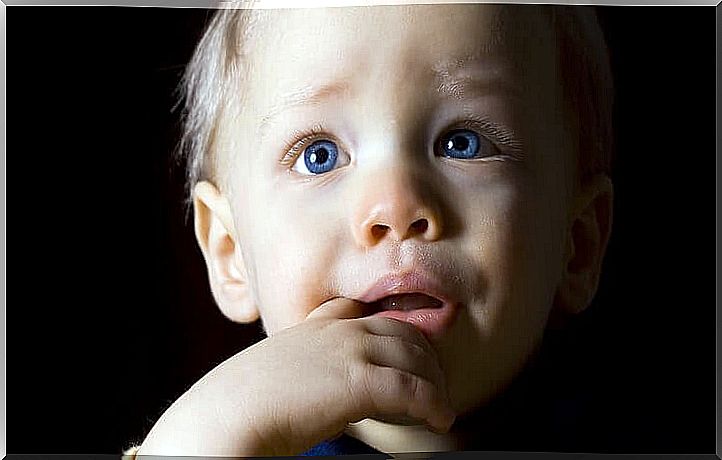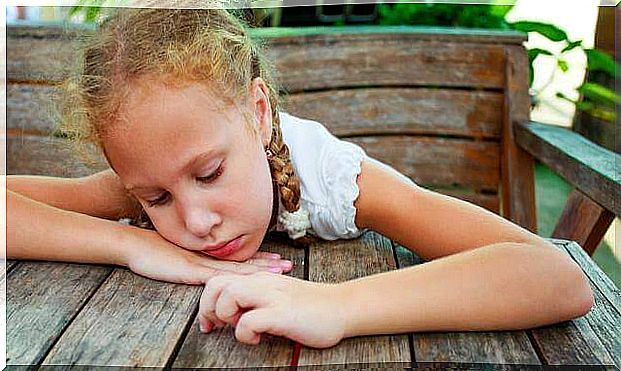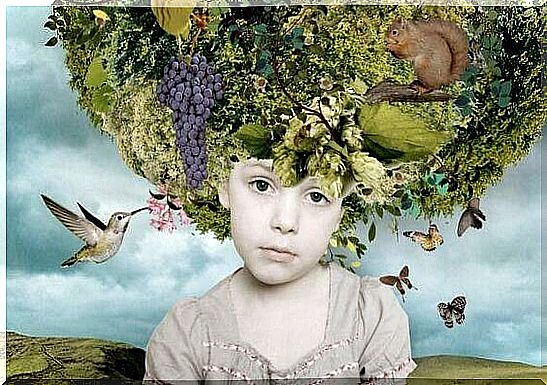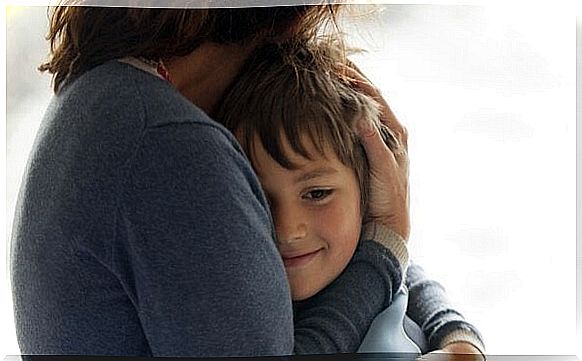Childhood Depression: Ignorance, Confusion And Forgetfulness

Childhood depression is a disorder that goes unnoticed: it is forgotten, unknown and confused with other disorders. Many people find it impossible for a child to fall into the grip of depression : “How are children going to get depressed if they don’t have responsibilities or worries? If they have everything…” . According to recent survey data, 1 child in 100 and 1 teenager in 33 suffer from depression.
The most serious problem is that only 25% of children and adolescents with depression are diagnosed and treated. Such a low percentage is a result of the fact that adults often overlook or ignore this problem or even misdiagnoses are made. A common misdiagnosis is what happens when a child is diagnosed with ADHD (Attention Deficit Hyperactivity Disorder) instead of depression.
Depressive symptomatology arises from certain personal vulnerabilities or is reflected in certain personal vulnerabilities. That is, because they do not have some social, emotional or cognitive skills and in situations that may require high performance if we take into account the person’s level, in this case the child, he may feel unable to respond, blocked. All of this generates a strong load of stress and a chain of negative emotions, such as sadness, meaninglessness, uselessness, fragility, emptiness or danger, among many others.
What characterizes a depressed child?
From sadness to depressive disorder there is a wide spectrum. Sadness, anxiety, hostility and anger are normal, adaptive and understandable emotions, necessary at certain times and which can be reflected in behavior. For example, fear is the emotion of danger and sadness is the emotion of loss. They are not harmful emotions in themselves: they help us to adapt to what is happening around us, to be safe if we feel danger or to write a story, our story, in which every loss ends up being given meaning.

Emotions cannot be categorized as illnesses. All children and all teenagers are sad at some point, they even feel symptoms of depression, but a depressive disorder is more than that.
It is important to know how to distinguish between sadness and possible childhood depression. For this, the frequency, intensity and duration of the behaviors must be taken into account, as well as the children’s malaise, how this interferes with their routine (if it does), if the child presents irritability, poor appetite , sleep problems, agitation and psychophysiological or motor symptoms.
In childhood depression, anger and irritability are frequent, while in adults, sadness and distress usually appear. Another different symptom in children is agitation. In the case of adults with depression, there is a decrease in motor and mental speed, while in children, greater activation is common (thus, to a certain extent, the confusion in the diagnosis with ADHD). Due to this change in symptomatology, childhood depression goes unnoticed or is confused with another type of behavior problem.
Many children go to consultations because they don’t want to do things, they are very irritated, angry, they have somatization (headaches, stomachaches, vomiting, diarrhea, etc.). The most reliable information we can obtain regarding a child’s thoughts and emotions is through the child. The adults in their environment, on the other hand, will be able to better inform about observable behaviors and specific moments.
Some vulnerability factors are a lack of social skills, a deficit in problem solving, social isolation, a negative self-concept, interpersonal difficulties with family or peers, and dysfunctional attitudes with thoughts of guilt. Often the emotional state they are in feeds on the “rumination” of certain thoughts, such as “Everything goes wrong with me, I’m a disaster, life isn’t worth it, it’s all my fault.”

Theory of learned helplessness and childhood depression
We are raising helpless children. One day they are rewarded and the next punished for the same behavior. Facts happen around them and nobody explains their origins to them. No limits are set, nor is it taught to tolerate and deal with frustration. It is very important to convey to children that to get what we like it is necessary to make an effort, wait, dedicate time, work, make mistakes and try again.
This learning takes place through personal experiences, but if we give everything ready, these rich experiences will be reduced to their minimum expression. That’s when behavior problems, outbursts of anger, mood swings, lack of impulse control, and a long, etcetera, arise.
The different elements (behavior, objects, people…) assume the value we give them and this value also depends on the effort and sacrifice that were made to conquer them. Over the years, and as we’ve grown, we’ve learned to establish relationships between our actions and the consequences they have.
This is critical because it gives us a sense of control and enables self-efficacy. Of course, not everything is in our hands, but we can do many things to lead our lives. If children do not realize this relationship, they will feel helpless. If they don’t learn the possible results that exist in front of their actions and if the consequences are random or diffuse, they will feel completely lost.
In theories of learned helplessness, it has been shown that the most important thing is perception, that is, realizing that what we do has consequences for what we will receive later. For example, if we realize that effort is an important thing to achieve our goals, then the effort will show up in our actions, but if the child realizes that the results depend on luck, he will assume the belief that acting is useless and unnecessary , she will become a vulnerable being. To prevent childhood depression, children need to feel that what they do has expected consequences for the environment and for themselves.
Dysfunctional beliefs in childhood depression
Dysfunctional beliefs are values upon which our self-esteem rests. Children learn distortions in their own beliefs from an early age, for example “If you are not the first, you will be a loser and if you are a loser, you are worthless”. In this way, we condition our interpretation of reality and of ourselves. When a child puts his own self-esteem on impossible ideas, sooner or later, he is doomed to feel frustrated, depressed, incompetent or useless because there will always be someone smarter or prettier, because mistakes are inevitable and because he cannot be satisfied everyone.
Children need to learn how to ponder from an early age. It doesn’t have to be absolute perfection or complete disaster. We can’t be one hundred percent at all times, but we can’t let it all go either. Life is not black and white, gray exists and so there will be times and areas of our lives where priorities need to be set. For example, during exams, children will learn that it is time to devote more time to their studies and, at the end of this period, they will be able to enjoy their friends, family and the environment in which they live for more time. It is important to learn to prioritize responsibilities and deal with time based on your own decisions and their consequences.

childhood suicide
Depression is one of the main factors that anticipate suicide, and ending the myths regarding this topic is a fundamental task to prevent it. 72% of depressed children and adolescents have suicidal ideas. In the case of children, these ideas can exist even if they do not verbalize them. Many children’s wishes are not expressed through words, but through other forms of communication, such as games or drawings. As adults, it is important to learn to “read between the lines” what children express.
Below we will identify some of the myths that exist in relation to childhood depression:
- “Suicide comes from the family” – In many cases, if a parent or a family member committed suicide, it is believed that the child is more likely to also try to take his own life. It is true that she had the wrong model of coping, but suicide is not genetically determined. You will need to talk to the child and especially speak clearly. It is very important not to silence the event or silence the child’s wishes and feelings. It will be necessary to converse in language adapted to her age, using concrete explanations that she is able to understand. It is essential to jointly find solutions to the problems for which the child seeks death as a liberating way out.
- “Whoever talks a lot never does it, it’s to draw attention” – It should never be taken for granted that there is no possibility of carrying out the act. For parents, it is difficult to face that their child has the desire to take his own life, but far from avoiding the problem, the most urgent thing is to face it. Thinking it won’t happen, but acting as if it could.
- “The decision is irrevocable” – Considering that the child’s ideas of suicide cannot change is another mistake. Feelings are ambivalent, dissatisfaction and fear are mixed together with the positive assessment of death. This is why it is so important to be aware of the verbal and behavioral signals that will allow us to intervene in time.
- “A suicide will be suicidal for life” – Desires are fleeting, most of the time children regret it and even feel ashamed of it . It takes time to talk about emotions and normalize the fact of having mixed feelings. In life there are very difficult experiences, but from them it is possible to learn a lot.
- “Talking about suicide leads to its consummation” – Turning suicide into a taboo can be one of the worst actions. Talking about the topic alleviates the discomfort and allows the person to express themselves. Empathizing, normalizing and trying to understand is the priority to find solutions.
- “A person who commits suicide has a mental disorder” – Another frequent mistake is to think that in order to want to take their own life, a person necessarily suffers from some psychological problem. Although depression is a risk factor for suicide, there is a large percentage of impulsive suicides in adolescents without mental disorders.
What to do in case of childhood depression?
In psychological interventions, the aim is to address the risk factors and problem behaviors that are associated with a child’s depression. The intervention involves the child, the family and the environment in which they live. With the child or adolescent, different coping skills are worked on, ways to solve problems, and great importance is given to learning how to process information and how to deal with emotional discomfort. The intention is to transform the automatic negative thoughts and self-evaluations the child can make of themselves and the world to maintain the emotional state they are in.

Parents are provided with guidance so that they can deal with their children’s behavior, encourage empathetic listening, control anger, avoid conflict, communicate messages and feelings effectively, learn to make decisions and change ways of interacting between family members.
In preventing depression in children, it is essential that the unconditional love is present. We must never condition affection on a specific action or characteristic of the child. It is positive that love is perceived as unconditional, as a bond that will survive any circumstance that arises. In addition, there must be sensible and coherently applied rules, the reinforcement of appropriate behaviors, waiting for rewards, the exercise of intrinsic motivation, firmness in relation to the coercion processes and the establishment of good communication.








